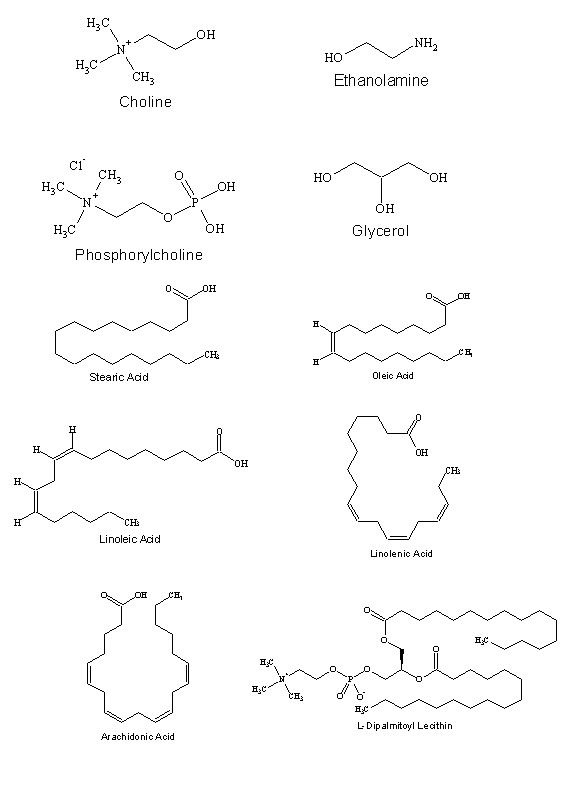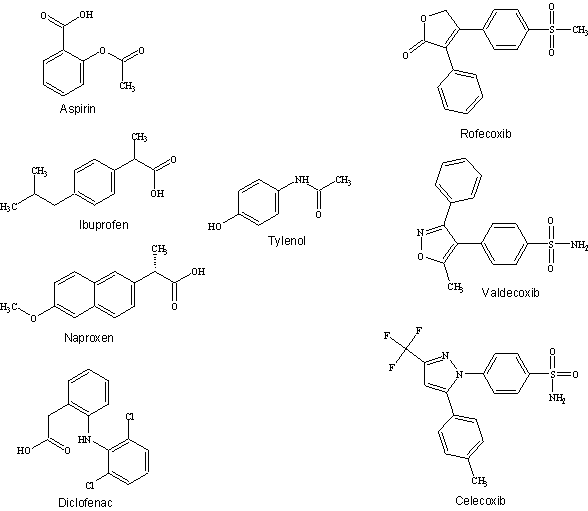CHEM106 Course Competencies (through
March 22)
Basics
-
Understanding electronegativity and underlying basis for electronegativity
trends in terms of fundamental laws of electrostatic interactions (Coulomb’s
Law).
-
Understanding and quickly predicting partial charges on atoms within neutral
molecules.
-
Drawing molecule structure showing all bonds from a given molecular representation
-
Aromatic electronic structure and geometry
-
Double/triple bonds and hybridization
Intermolecular forces
-
Relative magnitude (in kJ/mole) of chemical bonds (ionic, covalent and
metallic) vs intermolecular forces (hydrogen bonding, London dispersion
and dipole/dipole).
-
Diagram of intermolecular interactions among molecules.
-
Predicting points of potential H-bond donors and acceptors for any given
molecular structure.
-
Prediction of relative boiling points (also vapor pressure, melting
points, viscosity, surface tension) from molecular structure
Solubility
-
Polar (water soluble molecules) vs nonpolar (lipophilic molecules)
-
Surfactants and soap molecules
-
(not covered) --> Octanol-water partition coefficients and
significance (P and log P)
Kinetic Energy Distribution
-
Graphical representation and explanation of distribution
-
Distribution at various temperatures
-
Calculating fractions of molecules having KE greater than a given energy
at a given temperature
-
Understanding of KE conversion into potential energy to separate molecules,
to break bonds, or to react molecules
Chemical Kinetics
-
Two fundamental requirements for a chemical reaction to occur…
-
Reaction coordinate-energy profile (activation energy, heat gained or lost)
-
Role of catalysts
-
Understanding dependence of reaction rate changes with temperature
-
Calculating relative rates of reactions for different activation energies
or temperatures
-
Understanding relative impacts of temperature changes on reaction rates
for chemical reactions with low and high activation energies
Condensation reactions
-
Basic mechanism
-
Prediction of reactions between
-
Acids and alcohols
-
Phosphates and alcohols
-
Amino acids
-
Carbohydrates
-
Nucleotides
-
Esters
-
Hydrolysis reactions under acidic and basic conditions
-
Protein hydrolysis
-
Fat hydrolysis (e.g. formation of surfactant—soap--from animal fat and
lye)
Fats and fatty acids
-
Formation and structure of phospholipids (glycerol, serine, choline, ethanolamine)
-
Structure of Saturated, monounsaturated, polyunsaturated, and trans fats;
associated health effects
-
Cis- and trans- double bond geometry; formation of trans- fats
-
Relate the melting points of fats and oils to molecular structure
-
Olestra’s formation, structure, utility, and limitations
-
Molecular structure of membranes
Acid-Base Systems
-
Reaction of acids with water; reaction of bases with water.
-
Equilibria expressions for dissociation of weak acids and bases, Ka
and Kb; pKa’s
-
Henderson-Hasselbalch equation: be able to understand and use.
-
Prediction of predominant (and relative amounts) of acid/base forms (e.g.
COOH/COO-, –NH3+/-NH2 ) present at a given pH.
Amino Acids
-
Structure
-
Acid-base behavior at various pH’s
-
Knowing structure of common AA’s:
-
Nonpolar (glycine, alanine, valine, leucine, isoleucine, phenylalanine)
-
Polar (serine, tyrosine, cysteine)
-
Acidic (aspartic acid, glutamic acid)
-
Basic (lysine)
-
(not covered) --> Isoelectric points (pI) of amino acids
Proteins
-
Peptide bonds
-
Primary structure
-
Secondary structure; alpha helices and beta sheets
-
Interactions between side chains; tertiary and quaternary structure
-
Structure of globular proteins
-
Prions
-
Protein functions
Enzymes
-
Chemical Kinetics
-
Rate Law
-
Experimental procedure and methodology to determine reaction order
-
Calculation of rate constants and understanding of associated units
-
Experimental determination of activation energy, Arrhenius plots
-
Prediction of rate constants at different temperatures
-
Understanding of the effect of activation energy on degree of rate constant
changes with temperature
-
Michaelis-Menton kinetics
-
Equilibria
-
Reaction order as a function of substrate concentration
-
Use of Lineweaver-Burke equation to calculate Vmax, turnover
number, and KM
-
Effect of inhibitors, IC50
-
Significance of KM; relation of KM to enzyme-substrate
complex stability and to maximum reaction rate
-
Reaction energy diagrams
-
Understanding of noncovalent enzyme-substrate interactions
-
Enzyme inhibition
Cyclooxygenase Inhibitors (COX-1 and COX-2) and Nonsterioidal Anti-inflammatory
Drugs (NSAIDs)
-
Cyclooxygenase substrate and inflammation mechanism (e.g. phospholipid
release of arachidonic acid, generation of prostaglandins and thromboxanes
through cyclooxygenase pathway, of leukotrienes through lipoxygenase mechanism)
-
Mechanism of Action of COX inhibitors
-
Key structural features of NSAIDs and understanding of specific important
interactions with COX enzymes
-
Key differences between COX-1 and COX-2 enzymes and their respective inhibitors
-
Rationale for the development of COX-2 inhibitors
-
Understanding of resonance structures for COX - NSAIDs interaction geometry
and mechanism
-
Aspirin's unique mechanism of action for irreversible COX inhibition
Inflammation and Steroids
-
Understand the molecular basis of inflammation to include the role of phospholipases,
arachidonic acid, cyclooxgenase, lipoxygenase, prostaglandins, thromboxanes,
and leukotrienes
-
Understand the emerging relevance of inflammatory processes in various
diseases
-
Understand the importance of C-reactive protein levels and the enzyme drug
targets that pharmaceutical companies are focusing on
-
Explain the molecular mechanism of action for steroids as anti-inflammatories
-
Explain the effects of anabolic steroids and of each of the two classes
of corticosteroids (mineralcorticoids and glucocorticoids)
-
Understand the roles of prednisone and cortisone medications respectively
Nucleic Acids
-
Understand the structure of DNA and RNA to include the major components
and specific features; know how polynucleotides are synthesized and hydrolyzed
-
Clearly explain the underlying physical basis for the attractions between
the
two strands of double helix DNA
-
Understand the central dogma
-
Explain what a gene is, what it does, and the two roles of the major regions
(promoter and coding) of DNA gene templates
Complexes and Zinc Fingers
-
Understand the structure of complex ions and be able to explain the basis
for their interaction
-
Relate Lewis acid/base chemistry to complex ion components
-
Clearly explain why complexes are colored and demonstrate an understanding
of relevant molecular orbital energies
-
Show how transition metal ion valence electron energy levels shift as ions
are introduced into octahedral and tetrahedral ligand environments; understand
and be able to clearly explain the basis for these shifts
-
Understand and diagram the structure of important biochemical complexes
to include iron in hemoglobin, magnesium in chlorophyl and cobalt in B-12.
-
Diagram and effectively discuss the structure of zinc fingers; clearly
show the amino acid residues that interact with the zinc ion and how zinc
fingers affect protein shape
-
Explain the underlying basis for the zinc finger mechanism of action in
steroidal interactions with DNA
-
Discuss a new area of drug research that targets the zinc fingers in estrogen
receptors to treat breast cancer
Thermodynamics and Electrochemistry
-
Understand and be able to use the Second Law of Thermodynamics to predict
reaction spontaneity
-
Clearly explain how spontaneity is related to Free Energy change.
-
Calculate Free Energy changes necessary to move substances across concentration
gradients and to move ions across potential gradients
-
Demonstrate the ability to calculate Free Energy changes, equilibrium constants,
and electric potentials associated with given reactions
-
Use tables of reduction potentials to predict reaction spontaneity
-
Be able to relate concentrations to associated electric potentials (e.g.
Nernst Equation) and changes in Free Energy
-
Explain Free Energy changes associated with ATP-ADP interconversion; discuss
and effectively use the concept of coupled reaction energetics
-
Understand the sodium-potassium pump mechanism to maintain ion concentration
gradients and the array of energetics associated with this
-
Understand the role of oxidative phosphorylation as the major energetic
source to generate ATP; outline the specific redox reaction that is coupled
to ATP production
Neurochemistry
-
Understand the relative intracellular and extracellular concentrations
of sodium, potassium, calcium, and chloride ions
-
Explain and calculate cell membrane potentials associated with ion concentration
gradients
-
Relate resting membrane potential to ion permeability and to intracellular/extracellular
concentrations
-
Describe the structure of voltage gated sodium ion channels and potassium
ion channels to explain how they work. Understand the role of these
ion channels in moving nerve pulses down an axon
-
Outline and clearly explain the steps that occur to pass a nerve impulse
from one neuron to another
-
Understand the two (nicotinic and muscarinic) major classes of cholinergic
(acetylcholine) receptors and the mechanism of action for each
-
Understand the role and the basic general mechanism of G-Protein Coupled
Receptors (GPCR) in cell signaling processes; explain the importance of
these receptors in the pharmaceutical industry
-
Clearly explain the two major mechanisms used to reduce neurotransmitter
concentration levels at nerve synapses
-
Know the structure of acetylcholine and explain how it is synthesized and
hydrolyzed
Ion Channels
-
Describe what an ion channel is and the specific properties of the substance
that forms the channel
-
Understand and be able to clearly explain the physical basis for the selectivity
of sodium and potassium ion channels
-
Outline the difference and define what is meant by voltage-gated and ligand-gated
ion channels
-
Understand how increased permeability can affect voltage-gated ion channels
Neurotransmitters
-
Know the molecular structures for these neurotransmitters:
-
Cathecholamines: L-Dopa, dopamine, norepinephrine, and epinephrine
-
Amino Acids: Glutamate, Aspartate, Glycine, GABA (gamma-aminobutyric acid)
-
Understand the role of glycine and GABA receptors
-
Be able to explain the electrochemical basis for their inhibitory effects
-
Clearly explain how each of the following substances affects the GABA-ergic
system: ethanol, barbiturates, strychnine, diazepam (valium), and caffeine
-
Understand how PCP (angel dust) and Memantine (Namenda) affect the glutamate
receptor NMDA (N-Methyl-D-Aspartate)
-
Understand the synthesis steps involved in the production of L-DOPA, dopamine,
norepinephrine, and epinephrine
-
Explain the role of monoamine oxidase (MAO) for catecholamine neurotransmitters;
identify the role of MAO inhibitors.
-
Explain the effect of dopamine levels on brain activity
-
Explain the effects of cocaine and of amphetamines on the dopamin-ergic
system
-
Outline the role of seratonin and identify the substance from which it
is produced
-
Explain what SSRI's are and what they are used for
-
Classify the role of the three main types of norepinephrine receptors (alpha,
beta 1, and beta 2)



